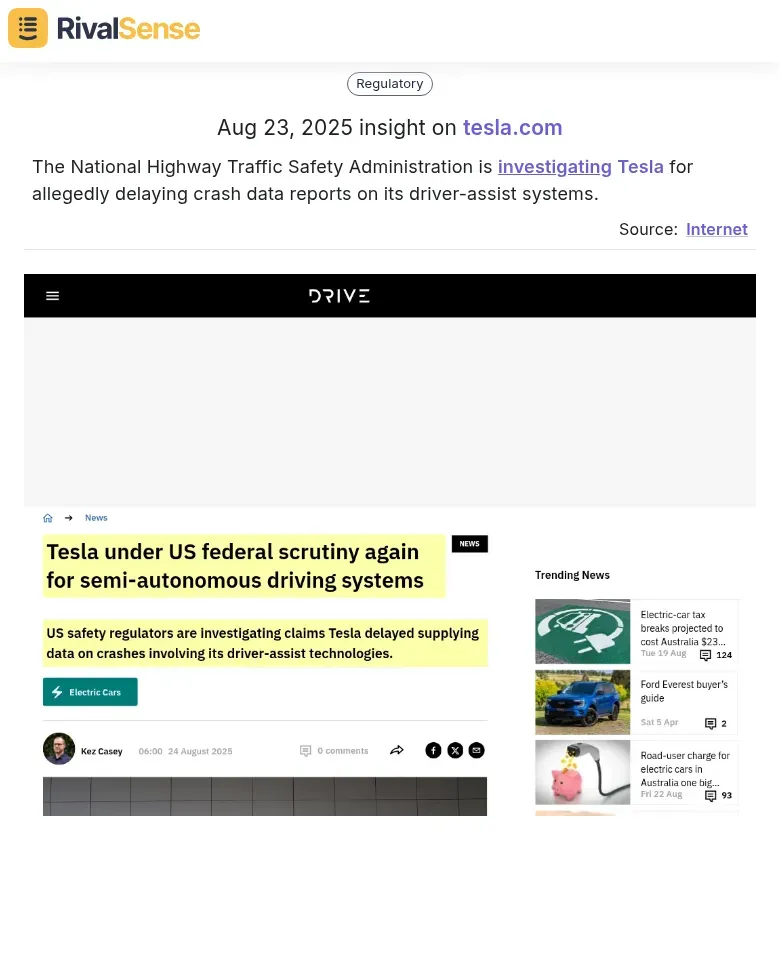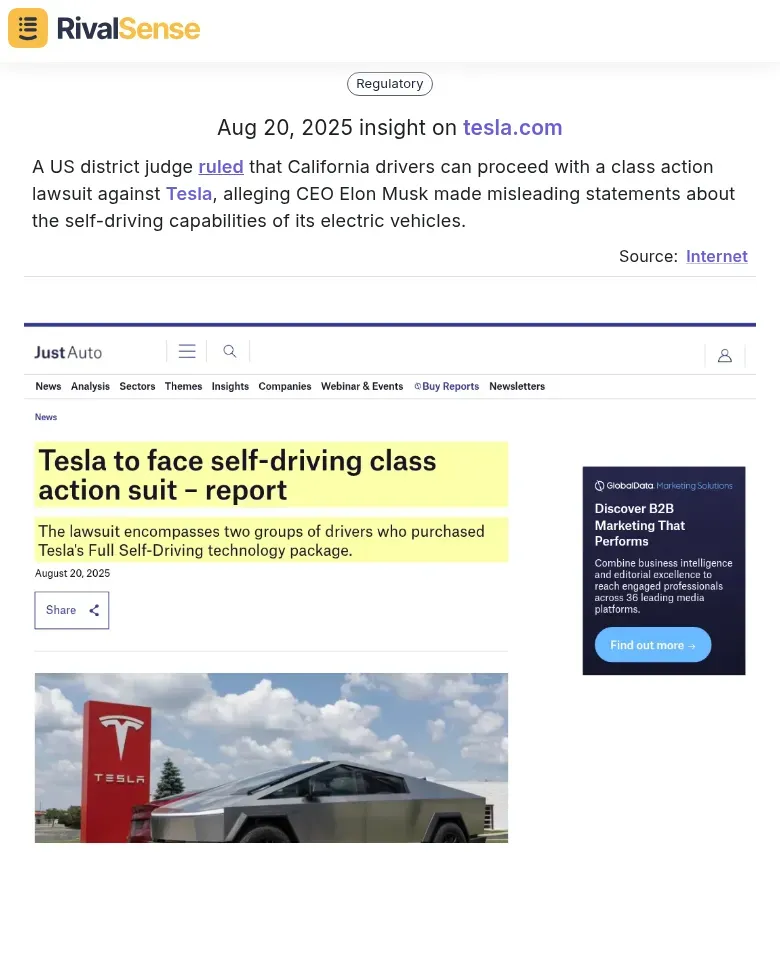How to Turn Competitor Regulatory Insights into Key Account Growth
In today's hyper-regulated business environment, regulatory compliance tracking has evolved from a defensive cost center to a powerful competitive differentiator. Companies that master competitor regulatory intelligence gain 3-6 month advantages in market adaptation and experience 28% faster response to new regulations. This strategic shift transforms compliance from mere risk mitigation into a growth engine for key accounts.
Practical Framework: Implement a 5-step monitoring system: 1) Identify critical regulatory touchpoints (GDPR, SEC filings, industry-specific requirements), 2) Establish 80+ monitoring sources including government databases and competitor websites, 3) Deploy AI-powered automated tracking tools, 4) Categorize intelligence by impact level and competitor strategy, 5) Integrate insights into account planning and risk management.
Key Action: Set up weekly automated alerts for competitor compliance changes. Track enforcement actions, policy updates, and market entry adaptations to identify growth opportunities where competitors struggle. This intelligence directly informs strategic account conversations, positioning your solutions as compliance-ready alternatives.
Learning from Regulatory Investigations: Proactive Risk Mitigation
When competitors face regulatory scrutiny, it's not just their problem—it's your opportunity for proactive risk mitigation. Extract early warning signals by monitoring regulatory databases, SEC filings, and legal disclosures for patterns that could impact your market. For example, if a competitor receives multiple compliance violation notices in a specific region, this signals potential regulatory tightening you should anticipate.

Example: The National Highway Traffic Safety Administration is investigating Tesla for allegedly delaying crash data reports on its driver-assist systems. Monitoring regulatory investigations like this provides early warning signals about potential industry-wide compliance tightening that could impact your business strategy.
Benchmark your compliance maturity against investigated competitors using this checklist:
✅ Compare incident response times (aim for 20% faster than industry average)
✅ Audit training program comprehensiveness quarterly
✅ Measure regulatory approval speed against top performers
✅ Track compliance investment as percentage of revenue
Develop proactive strategies based on competitor missteps: Implement automated monitoring of regulatory filings, create threshold alerts for enforcement actions, and conduct quarterly competitor compliance audits. When a competitor faces penalties for data privacy violations, immediately review and strengthen your own protocols. This demonstrates to key accounts that you're not just compliant—you're ahead of the curve, building trust through visible risk mitigation leadership that directly enhances retention.
Competition Law Violations: Turning Legal Setbacks into Growth Opportunities
When competitors face competition law violations, analyze their pricing patterns that led to breaches—often involving price-fixing, market allocation, or algorithmic collusion. For example, if a rival is fined for anti-competitive pricing, identify the affected customer segments and pricing gaps. Use this intel to target underserved markets with compliant, transparent pricing strategies.

Example: Coop is disappointed that the Competition Appeals Board ruled it breached competition law in the price hunter case, as stated by Ingvill Størksen, Director of Policy and Government Relations at Coop Norge. Tracking competition law rulings helps identify market gaps and pricing strategies that avoid regulatory pitfalls while capturing competitor weaknesses.
Steps: 1) Monitor regulatory databases for competitor violations; 2) Map their restricted activities to market opportunities; 3) Position your offerings as trustworthy alternatives by highlighting compliance and ethical practices. Tip: Leverage their compliance failures in marketing to emphasize reliability, such as showcasing certifications or audit results to build customer trust and capture market share during their downtime.
Class Action Lawsuits: Customer Trust and Market Positioning Insights
Class action lawsuits against competitors reveal critical customer dissatisfaction patterns that can inform your service improvements. Monitor legal databases and news alerts for competitor litigation to identify recurring issues like billing disputes, data privacy breaches, or product defects. For example, if a competitor faces class actions over misleading pricing, implement transparent pricing models and clear communication.

Example: A US district judge ruled that California drivers can proceed with a class action lawsuit against Tesla, alleging CEO Elon Musk made misleading statements about the self-driving capabilities of its electric vehicles. Following class action developments helps identify customer trust issues and product claim validation requirements that can strengthen your own market positioning.
Extract validation requirements from competitor litigation outcomes. Analyze court rulings and settlements to understand what product claims require substantiation. Create a checklist: verify all marketing claims with data, document testing procedures, and avoid absolute statements like "best" or "guaranteed" without evidence.
Build enhanced customer protection measures by addressing competitor vulnerabilities. If competitors face lawsuits over data handling, strengthen your privacy policies with explicit consent mechanisms and regular audits. Implement proactive transparency: provide clear terms of service, easy opt-out options, and regular compliance training for your team. This not only mitigates legal risks but also builds trust for key account growth.
Integrating Regulatory Insights into Key Account Strategy
Integrating regulatory insights into your key account strategy transforms compliance from a cost center into a growth engine. Start by analyzing competitors' regulatory challenges in similar industries to develop compliance-driven value propositions. For example, if a competitor faced GDPR fines, create tailored risk mitigation plans for key accounts that address those specific vulnerabilities. Use tools like RivalSense to track 80+ regulatory sources and identify patterns in competitor compliance failures.
Practical steps: 1) Map key accounts' regulatory pain points against competitor intelligence, 2) Develop customized compliance solutions that preempt risks competitors encountered, 3) Position regulatory expertise as your differentiator in retention conversations. Include checklists for monitoring competitor enforcement actions, compliance document changes, and market adaptations weekly. This approach not only mitigates risks but demonstrates proactive value, turning regulatory intelligence into account growth opportunities.
Implementation Framework: From Insights to Account Growth
To transform regulatory competitor insights into tangible account growth, implement a three-step framework:
-
Automated Monitoring Systems: Set up real-time alerts using tools like RivalSense to track competitors' regulatory filings, compliance updates, and policy changes across key accounts. Create custom dashboards that flag regulatory shifts affecting your top 20% revenue-generating accounts. Tip: Use AI-powered platforms that monitor 200,000+ sources including regulatory portals and news sites.
-
Cross-Functional Processes: Establish a weekly regulatory intelligence meeting with sales, marketing, and product teams. Use battle cards to translate regulatory changes into specific account opportunities. For example, when a competitor faces new compliance requirements, your product team can develop compliant features while sales targets affected accounts with tailored messaging.
-
Impact Measurement: Track key metrics including:
- Revenue growth rate from existing accounts (target: 15-20% increase)
- Customer retention rate (aim for >90%)
- Net Revenue Retention (NRR) - benchmark against 106% industry median
- Regulatory-driven deal velocity (measure time from insight to closed-won)
Practical checklist: Implement quarterly audits of your regulatory intelligence ROI by comparing account growth in monitored vs unmonitored segments, and adjust your tracking parameters based on what drives the highest revenue impact.
Ready to turn competitor regulatory insights into account growth? Try RivalSense for free and get your first competitor report today. Track product launches, pricing changes, regulatory developments, and more—delivered in a comprehensive weekly email that keeps you ahead of the competition.
📚 Read more
👉 GF Inbursa Increases Telcel Oro Credit Card Fees: A Competitor Analysis Breakdown
👉 Business Partnership Training Programs: Best Practices & 2025 Implementation Guide
👉 Measure Custom Software Partnership ROI: Key Metrics and Practical Strategies
👉 How Caterpillar Countered Rolls-Royce's Saudi Rail Win: A Competitive Intelligence Case Study
👉 Extracting Financial Insights from Facebook Competitor Analysis
